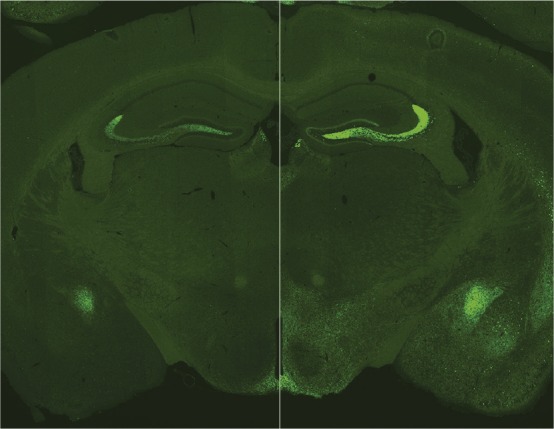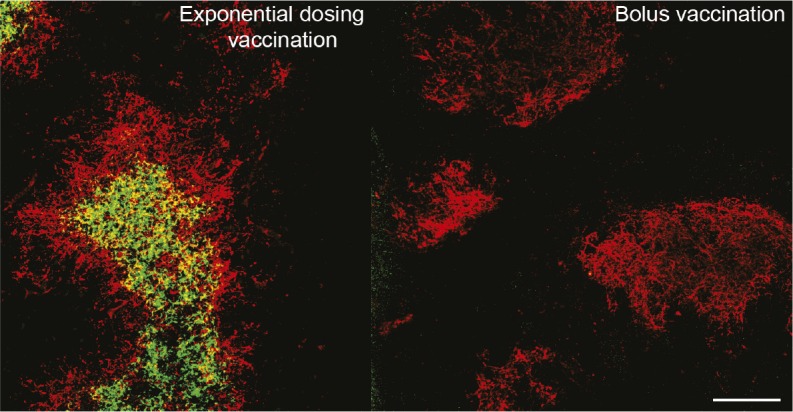How birds survive diving into water

Northern gannet. Image courtesy of Pixabay/annca.
Some seabirds, such as gannets and boobies, dive into water at a speed of 24 m per second while hunting. The birds’ slender necks appear fragile, yet do not crumble under the compression experienced during high-speed water impacts. The mechanics of this process are not well-established. Brian Chang et al. (pp. 12006–12011) used experimental dives by a dead, frozen northern gannet and diving bird models to test the limits of neck stability of plunge-diving birds. The authors found that hydrodynamic drag forces on the head can cause the birds’ necks to buckle, but analysis of musculature showed that strong neck muscles allow the birds to survive compression forces two orders of magnitude greater than their normal dives. By manipulating the dimensions and dive form of the diving bird models, the authors demonstrated that increasing the dive velocity and neck length increases the likelihood of buckling. The compression force on the neck increased with skull radius, impact velocity, and beak angle. According to the authors, the birds would have to dive at a speed of around 80 m per second for their necks to buckle, although humans would likely sustain neck injury at a speed of 24 m per second. — L.C.
Lethal violence among humans
The origin of lethal violence in human society remains unclear. Some anthropologists hold that violence among small groups was common throughout prehistoric times, whereas others maintain that violence became prevalent with complex sociopolitical organizations. Mark Allen et al. (pp. 12120–12125) investigated the relationship between lethal trauma, resource shortages, and political complexity. Resource shortages are intervals when violent actions may result in high personal gain, whereas political complexity refers to periods when leaders may have the power to force cooperative participation in conflict. Drawing on a large sample of hunter-gatherer skeletons buried in central California 1,530 to 230 years ago, the authors compared the pattern of blunt and sharp force skeletal trauma to sociopolitical measures and environmental productivity estimates. The authors found that sharp force trauma, the most common form of violence recorded, was more closely tied to resource scarcity than political complexity, and that sharp force trauma increased as productivity declined. Blunt force cranial trauma was not associated with resource availability and may represent another form of close contact violence. According to the authors, the study may explain why violence can increase in specific times and locations throughout human history and help predict when and where violence will arise in the future. — L.C.
Frequency of Hurricane Sandy-like floods

Flooding on FDR Drive in Lower Manhattan following Hurricane Sandy. Image courtesy of Wikimedia Commons/Beth Carey.
The storm surge due to Hurricane Sandy caused flooding nearly 3 m above high tide in New York City in October 2012. The frequency at which such flooding occurs varies with changes in sea level and storm surge climatology, and estimating changes in this frequency over time could be valuable for risk mitigation. Ning Lin et al. (pp. 12071–12075) investigated how the frequency of Sandy-level floods in New York City has changed from 1800 to the present, and estimated the frequency of future floods. The authors estimated past sea levels from historical data and future sea levels from probabilistic projections under moderate greenhouse gas emissions. Further, the authors used reanalysis data and global climate models to estimate the current and future frequency and severity of storms. The authors estimated that the frequency of Sandy-level floods has approximately tripled since 1800, from once every 1,200 years to once every 400 years, and will increase to once every 90 years by the year 2100 due to the effects of sea level rise alone. When future changes in storm climatology were taken into account, the estimated frequency in 2100 varied from once in 23 years to once in 130 years, depending on the particular climate model used, according to the authors. — B.D.
Postoperative pain and cognitive dysfunction

Brain BDNF expression in control mouse (Left) and following orthopedic surgery (Right).
Postoperative pain is a common complication of surgery that is associated with delirium and cognitive dysfunction, particularly in the elderly. To better understand the connection between postoperative pain and cognitive dysfunction, Ming-Dong Zhang et al. (pp. E6686–E6695) studied pain-associated behavior and nerve injury biomarker expression in mice undergoing orthopedic surgery to repair fractured bones. Mice exhibited increased cold sensitivity, characteristic of neuropathic pain, following surgery, along with increased expression of brain-derived neurotrophic factor (BDNF) in sensory neurons. BDNF expression in sensory neurons also increased following transection of the sciatic nerve, suggesting that BDNF is a marker of nerve injury. However, elevated BDNF levels persisted for at least 2 weeks following surgery, whereas following nerve transection, BDNF returned to baseline levels or less after 2 weeks. BDNF levels also increased in mossy fibers in the hippocampus following surgery, even though the corresponding mRNA levels did not change and hippocampal neurogenesis, which BDNF stimulates, decreased. The results suggest that bone fracture and surgery led to impaired BDNF signaling in the hippocampus, possibly by inhibiting BDNF release from mossy fibers. This impaired BDNF signaling might contribute to postoperative cognitive dysfunction, according to the authors. — B.D.
Nontraditional vaccine dosing and immune response

Exponentially increasing dosing leads to efficient antigen (green) trapping on follicular dendritic cells (red), compared with bolus vaccination.
Nonlive vaccines are typically given in a single dose, in contrast to a natural infection, which exposes the immune system to escalating antigen levels over time. Hok Hei Tam et al. (pp. E6639–E6648) investigated the efficacy of administering escalating doses of HIV antigen to mice over a 1–2 week time period, via repeated injection or osmotic pumps, compared with single-dose vaccination. Exponentially increasing antigen dose over 2 weeks increased antibody concentration more than 10-fold, relative to single-dose immunization. Exponentially increasing antigen dose over time also led to increased antibody concentration, relative to maintaining or decreasing antigen dose over time. Computational modeling suggested that exponentially increasing the dose leads to prolonged antigen retention in lymph nodes and allows time for higher-affinity antibodies to develop. Prompted by this model, the authors injected mice with the fluorescent protein phycoerythrin. Little or no antigen could be detected in lymph nodes 24 hours after single-dose immunization, while substantial amounts of antigen could be detected in lymph nodes 24 hours after the final injection in the exponentially increasing regimen. Taken together, the results suggest that regulating antigen kinetics may lead to effective vaccines against pathogens such as HIV, according to the authors. — L.G.


